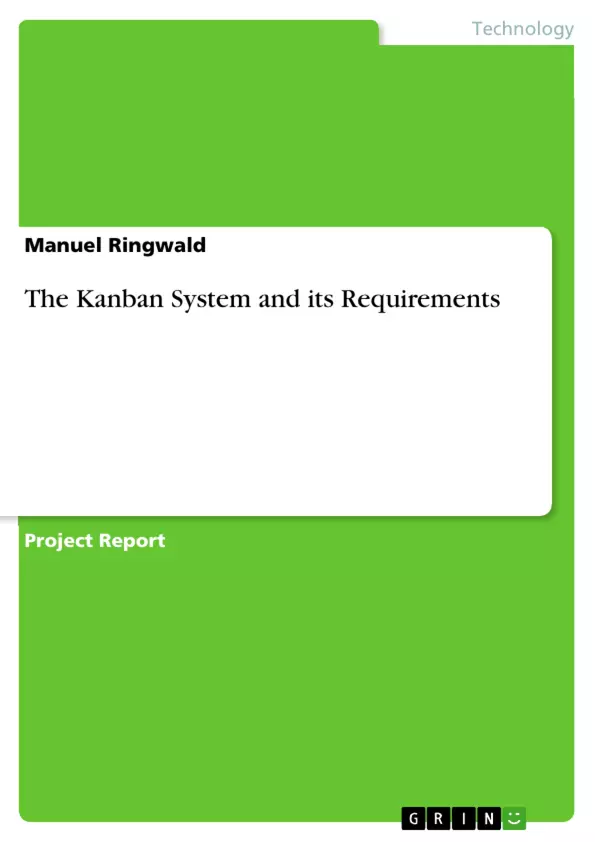1 Abstract
It is said that a Kanban-System improves a process by changing the information flow in the process and rearranging rules of responsibilities. The purpose of the study was to find out what a Kanban is, what does it make the superior application to conventional western strategies, and what are the weak points of it. Furthermore, the study aims to have a look at the supporting environment to find out if there are requirements for a Kanban-system to be successful. To control and to measure the success of an introduced Kanban system, various methods and tools were examined, compared with conventional methods and tools, and presented. Finally, the study tried to use all collected information for a theoretical approach how to introduce a Kanban system step by step. To get an unprejudiced sight on this topic the development over the last years, scientific journals, and books from the early 80s until today were inspected.
The principal conclusion of the study was that Kanban can be a very efficient method to improve processes, to reveal problems, and to involve worker more in processes for improved motivation that results in a process improvement. But this needs a good prepared environment with trained staff through all levels. And the more a process is complex due to complex products, the more it is essential that the environment is working properly. Furthermore, the need of controlling tools and proper consequences seemed to be a significant part that decides over success or fail.
Table of Contents
:- Abstract
- Introduction
- Kanban - The Japanese Way of Life
- What are the advantages of Kanban? Worth the sweat?
- I’ve seen all the benefits, but what’s the catch?
- Blocking Mechanism
- Cycle Issue
- From Simple Cards to High-Tech Devices?
- Show Me Your Cards And I’ll Tell You How Successful You Are
- Process-Environment: The true power of a company
- Kaizen
- Seven forms of waste
- Just-in-Time
- 5s Circle
- Six rules for Kanban
- Value Stream Mapping
- Controlling
- Visual Management
- Process Control Chart
- A Theoretical Approach
- Analysing the initial state
- Step by Step - What Needs To Be Done
- Comment
Objectives and Key Themes
: This study investigates Kanban, a Japanese management system that aims to improve processes by optimizing information flow and rearranging responsibilities. The study seeks to answer what a Kanban system is, how it compares to conventional Western approaches, and its potential weaknesses. It explores the environment required for successful Kanban implementation, examines control methods, and provides a theoretical approach for introducing a Kanban system step-by-step. Key themes include: * **Kanban system definition and function:** The study explores the purpose and structure of Kanban systems, its principles, and its strengths and weaknesses. * **Kanban in the context of Lean:** The study analyzes how Kanban fits within the broader Lean management philosophy, highlighting its interdependence with other Lean practices. * **The importance of environment:** The study emphasizes the importance of a prepared environment for successful Kanban implementation, including trained staff, clear processes, and supporting strategies like Kaizen. * **Control and measurement:** The study examines various methods and tools used to control and measure the success of Kanban systems, contrasting them with conventional methods. * **Theoretical implementation:** The study proposes a theoretical approach for introducing a Kanban system in a step-by-step manner, drawing on all gathered information and research.Chapter Summaries
: The study begins by introducing the concept of Kanban as a simple card or board containing essential information for a process flow. It describes the pull strategy, which minimizes waste and focuses on customer demand, in contrast to the push strategy, which relies on a centralized production control system. Chapter 3 then delves deeper into the advantages and disadvantages of Kanban, exploring blocking mechanisms and cycle issues that can arise. The chapter also examines the role of technology in Kanban, discussing eKanban and the continued importance of physical cards. Chapter 4 focuses on the supporting environment necessary for successful Kanban implementation. It discusses Lean principles like Kaizen, the seven forms of waste, Just-in-Time production, and the 5s Circle. It also outlines six specific rules for Kanban implementation. Chapter 5 explores control methods used for Kanban systems, comparing them to conventional approaches and emphasizing the importance of visual management and process control charts. Finally, Chapter 6 presents a theoretical approach for transitioning a company from an MRP II-controlled process to a Kanban-controlled pull process. This approach involves analyzing the initial state of the process using value stream mapping, implementing Kaizen and 5s methods, adjusting communication with suppliers and customers, and introducing Kanban.Keywords
: The main keywords and focus topics of the study are Kanban, Lean, Just-in-Time, Kaizen, pull strategy, push strategy, visual management, process control charts, and value stream mapping. The study also explores the importance of a prepared environment, staff training, and the role of technology in implementing a successful Kanban system.- Quote paper
- Manuel Ringwald (Author), 2013, The Kanban System and its Requirements, Munich, GRIN Verlag, https://www.grin.com/document/229794



